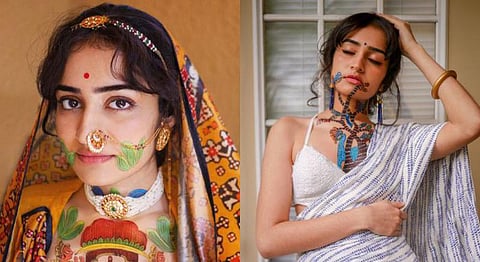
- HOMEGROWN WORLD
- #HGCREATORS
- #HGEXPLORE
- #HGVOICES
- #HGSHOP
- CAREERS
- ABOUT US
- CONTACT US

Niharika Elety, who studied South Asian art for six years in Hyderabad, has been creating art since she was 5 years old. The first piece of art that impacted her was a Warli painting by Jivya Soma Mashe that depicted beautiful relationships between human beings, plants, animals, and the Earth.
“This is what introduced me to Indian art and sparked my interest in learning about tribal communities across India,” she remembers.
Through her recent South Asian art series itself, she wants to bring an awareness about the diverse ancient art forms of India and South Asia, and where or which tribes they originated from, by using herself as a canvas.
“I want to reach out to the Indian diaspora or people even within India, who are unaware about their indigenous art styles and crafts,” says Niharika.
Sustainability is another element that is incredibly important to her and she wishes to engage with that through eco-friendly practices in arts and textile traditions.
Her artistic philosophy, which incorporates South Asian heritage as a recurring theme, is pivoted on the preservation of our heritage and re-contextualising it for the new world. Besides, she also looks to the natural environment for inspiration, subsuming it as a predominant motif in her art.
“Human beings have dissociated themselves from their natural environment so much so that they don’t recognise what impact their actions have on the Earth. This has created an inimical narrative of being complacent about environmental destruction, which is what I have tried to address in my design,” says Niharika.
The inspiration in her creative journey has been artists, weavers, garment workers, and all those people who dedicate their lives to art in its various forms and measures. “Being surrounded by people who are passionate about what they do is empowering, and enriching,” she says, and so, she makes sure to interact with her family, friends, and creatives to give her new perspectives into her work when she is stuck.
“The other thing that inspires me,” she says, “is the role of art in fighting for social, cultural and environmental justice. There are so many incredible activists, grassroots organisations and creators working to protect the people and the planet. I learn so much from them and am inspired to share and build upon their work.”
In fact, through her work, she would like to support and endorse any project led by an Adivasi person (whether it be in terms of their culture, food, art, or fabrics) in order to help them in their struggle towards attaining both personal and political autonomy. She wants to revive the indigenous knowledge of art and crafts, as well as traditional modes of conservation and sustainable practices, which have been pushed into oblivion for decades. Reconnecting with the natural world both to address the pervading ecological crisis, as well as to decolonise the indigenous art forms are some of the ways she feels that can be done.
Quick questions with Niharika
I. Are there any Indian contemporaries of yours whose work you admire?
The Vayeda Brothers are inspirational Warli Artists reclaiming the art for their tribe. The Warli art has been commercialised by non-tribals so much that actual tribal artists are out of work. I also admire @artwhoring by Priyanka Paul. She is constantly talking about important movements like Dalit Lives Matter and Shaheen Bagh and I love how she incorporates social justice themes into her work. I also love Simrah Farrukh’s photography because she captures BIPOC communities with her own painting-like style.
II. Which is your favourite piece of work of your own & why?
I think my South Asian art series is my favourite since I have made it with a lot of care and attention. I wanted it to be a medium for people who aren’t aware of South Asian art forms, to learn a bit about our heritage. I also love the South Asian Textile series which showcases the importance of handloom weaves and cultural crafts in bolstering communities with a sense of sovereignty. In this, I display the different weaves around India/South Asia as well as the weaving processes and the communities involved.
III. One track you’re currently listening to?
The Bandish Bandits songs have been on replay lately. It’s been a while since I have heard classical music in mainstream media and I love it.
IV. A project you were inspired by?
I absolutely love G Venkat Ram’s recreations of Raja Ravi Varma paintings with South Indian actors. It was so beautifully done, that I was inspired to recreate the same with other lesser-known Raja Ravi Varma paintings! I think this project was extremely important because South Indian representation is hard to come by in a positive light and without being homogenised. It was also a beautiful ode to Indian heritage art.
IX. Your favourite midnight munchies?
Boondi and Sakinalu! I love hot and savoury Indian snacks.
X. Your greatest vice?
I think my greatest vice is the insecurity I face with my work. I have fallen into the trap of comparing myself to contemporaries, like most people. I am working on being more confident and intentional with my art.
If you enjoyed reading this article, we suggest you also read:
